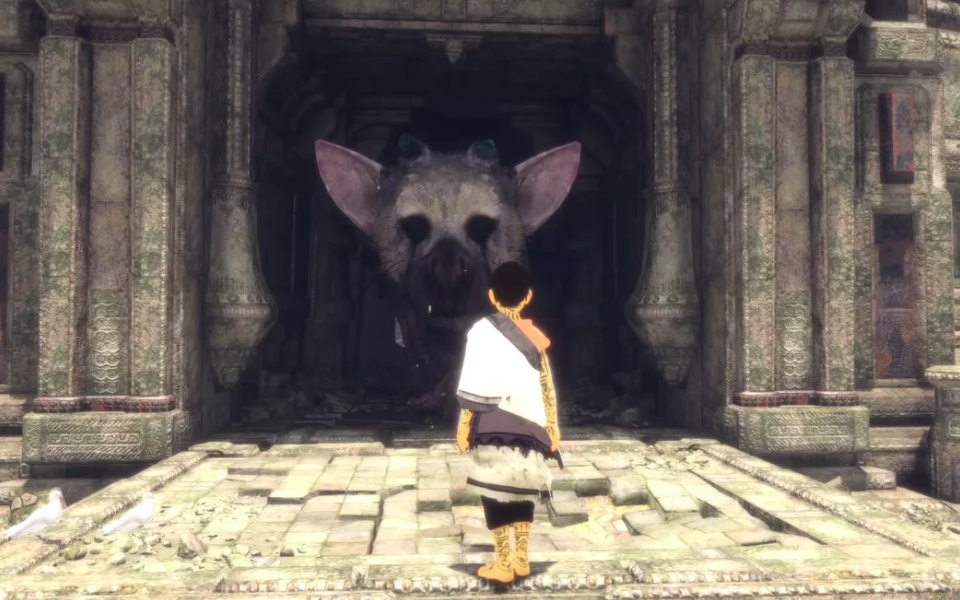The Last Guardian review: 10 years in the making, Fumito Ueda’s new game is a flawed work of genius

Playing The Last Guardian is like booting up a fondly half-remembered game from your childhood. Almost 10 years in the making, Japanese designer Fumito Ueda’s follow-up to his elegiac PS2 titles Ico and Shadow of the Colossus comes with a monumental weight of expectation; its protracted development – only snippets of which were glimpsed over the years – has become the stuff of legend. The result is both a frustrating anachronism and a beautiful oddity.
Its beating heart is the relationship between a young boy and a monstrous, griffin-like creature called Trico. Both awake in an unfamiliar cave, Trico’s feathery hide bloodied and pocked with spears – your first task is to tentatively patch him up and calm him down. This sets the tone for things to come: it’s about reflection and friendship, not skill and aggression. There is an option to “comfort” but not to “attack”.
Trico is The Last Guardian’s stand-out achievement, an astonishing creation that combines elements of cat, dog, bird and rodent, all seamlessly blended into a beast that’s equal parts adorable and terrifying. He walks with the ponderous grace of a lion, bats at butterflies like a household cat, but his personality is unmistakably canine. His mannerisms – cocking his head as he strives for understanding, shaking water from his feathers, scratching behind his ears – is a masterclass in motion-capture and observation.
As you progress, you form a bond with him, and can suggest he carries out increasingly sophisticated tasks, which he may or may not pay any attention to. He might boost you up to an unreachable ledge, but he's just as likely to wander back the way you just came for no reason whatsoever. Given he’s the key to solving virtually every puzzle in the game, this makes him a frustratingly mercurial companion; at one point I jumped and waved my arms at him for an hour – literally an hour – begging him to carry out the simple manoeuvre that would progress the story.
You piece together a narrative based on what you can see; an injured creature, a crumbling world, a lingering, malign energy.
The Last Guardian’s second revelation is its environmental story-telling. Continuing in the vein of Ico and Shadow of the Colossus, there are no expository cut-scenes, no books of lore to pore over, no in-game dialogue. You piece together a narrative based on what you can see; an injured creature, a crumbling world, a lingering, malign energy. Even the sporadic narration – the voice of your future self – feels superfluous.
The towering world of temples and caverns, the deserted remains of a once magnificent city, borrows elements from feudal Japan, ancient Rome and the fantasy worlds of Tolkien, as well as the aesthetic of Ueda's previous work. This broken land spirals vertiginously towards the sun – if you ever get lost, the answer is almost always “up” – and while your path is linear, it feels vast and limitless.
It’s so beautiful, in fact, that you find yourself making excuses for the multitude of flaws: to call the disobedience of the creature a directorial choice rather than a technical limitation, to blame the niggly controls on the character rather than the developer. Trico and the boy are so well animated that you instinctively read a level of intelligence into their actions that just isn’t there.
 The boy and his magical beast Trico
The boy and his magical beast Trico
Less easy to explain is the persistently aggravating camera, which lurches around at will, leaving you blind to deadly precipices and oncoming enemies. There’s also a tendency to make you repeat tasks – fetch this, pull that – to the point that some sections feel like padding, and too much time is spent in tonally similar dungeons; moments when you emerge into glorious sunshine feel few and far between.
A relatively leisurely play-through will take 10-12 hours, but it could comfortably have been trimmed to eight without sacrificing any emotional weight, and you could knock off another hour or two if the beast would just behave himself.
While the technical limitations will soon be forgotten, the story of a small boy and his magnificent beast will go down in video-game history.
But unlike many modern games, which front-load the best sequences to draw in players and woo critics, the most engaging parts of The Last Guardian come in the final third. Simple tricks like changing the lighting from afternoon to dusk make you appreciate the world anew, reminding you what a glorious place it is.
The Last Guardian already feels nostalgic, displaced from time, reminiscent of classic platformers – Prince of Persia, Tomb Raider, Ueda’s previous games – and yet utterly new. It’s a classic in the making, and while the technical limitations will soon be forgotten, the story of a small boy and his magnificent beast will be spoken of for decades to come.
